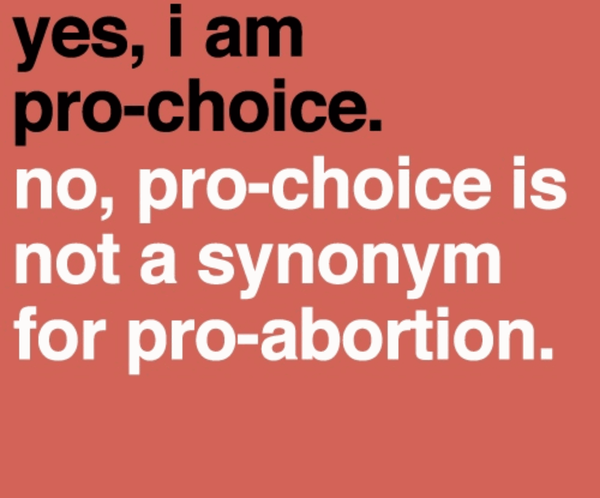Let's start by establishing that I agree with you. I'm not a fan of abortion. If I could save every single baby, believe me, I would. I agree with the end goal of the pro-life movement, but I disagree fundamentally with every way that they go about to achieve that end goal and I do not understand the correlation between people who fight for a child to be born, but will not fight for that child's rights after birth or when they find themselves in their own unwanted pregnancy. I am not pro-abortion, but I am pro-choice.
This is not meant to be an accusation, but rather a conversation. I am openly expressing what I believe to be right but I am open to hearing other opinions, even if those opinions may never sway mine. I will use only neutral sources (no abortion clinics and no religiously biased sources). Please feel free to contribute in the comments or to use this post as a basis for discussion between people of differing opinions. This issue is not a dichotomy and I believe that the resolution lies in compromise in the gray area. There are several ways that we can prevent abortions and de-funding health clinics or harassing women are not any of those ways.
The Goal: To Minimize the Number of Abortions Sought After in the United States
Things That Prevent the Achievement This Goal:
Abstinence-Only Sex Education: In 2009, when the funding for abstinence-only sex education expired, it was determined that "based on a national analysis of all available state data, (the) results clearly show that abstinence-only education does not reduce and likely increases teen pregnancy rates." A direct correlation was seen between states that promote abstinence-only sex education and states that saw the highest unintended teen pregnancy rates. On the contrary, states that promoted comprehensive sex education saw a decline in pregnancies among teenagers and abortion rates among the same population. By definition, comprehensive sex education "includes age-appropriate, medically accurate information on a broad set of topics related to sexuality including human development, relationships, decision-making, abstinence, contraception, and disease prevention." It does not factor abstinence out of the equation, but, rather, continues to teach it as the only 100 percent reliable method for preventing unwanted pregnancy and STD's. Regardless of which program is taught, teenagers are having sex--32 percent in 9th grade and 62 percent in 12th. If neither method is preventing teenagers from engaging in sexual activities, it is our responsibility as a nation to help minimize the effects of these behaviors, rather than hopelessly trying to terminate them.
Source: https://www.guttmacher.org/fact-sheet/unintended-p...
Limiting Access to Contraceptives: Colorado set a precedent by beginning to offer access to low- and no-cost long-term, reversible birth control to young women, especially those who come from low-income backgrounds. Between 2009 and 2013, the Colorado teen birth rate dropped 40 percent and the abortion rate among pregnant teenagers decreased approximately 42 percent during the same period. Both of these rates continue to decline steadily. Not only does sustainable, low-cost, long-term birth control access offer teenage girls lower risks of pregnancy and STIs, but it is also beneficial for the population as a whole. For example, "in 2010 alone, Colorado saved $42 million on health care costs associated with teen birth." An additional study done in St. Louis also shows a correlation between an increase in access to contraception and a decrease in abortion rates, from the national rate of 19.6 abortions per 1,000 women to 4.4-7.5 abortions per 1,000 women in the study and a teen birth rate of 6.3 births per 1,000 girls as compared to the national average of 34.3 births per 1,000 teen girls. Cutting access to contraceptives only increases the numbers of unintended pregnancies in a population and puts unnecessary restrictions on a woman's healthcare for personal or religious reasons.

Shutting Down Women's Health Clinics: In many areas; most notably Texas, Indiana, and Louisiana, the de-funding or closure of women's health clinics have led to a significant increase in the number of sexually transmitted diseases presented in a population and an increased inability to combat their effects. Vice-presidential candidate Mike Pence is being considered responsible for such effects in Indiana during his time as governor. In this particular situation, there was an HIV outbreak as the result of intravenous drug use and, since Pence had closed the only HIV treatment clinic in the county, he came under fire for this outbreak. In short, Planned Parenthood provides a number of services to people of any gender in their community, with abortion services comprising only 3 percent of their total care provided, and their closure has devastating effects on everyone that relies on them for reproductive healthcare.
Source: https://www.washingtonpost.com/news/fact-checker/w...
There are many ways that we can go about minimizing the number of abortions that are sought after in this country; particularly amongst teenaged girls. However, abstinence-only sex education, restriction of access to contraceptives, and closing health clinics are not any of the ways in which we can reach this end goal. Rather, our focus should be on educating students and making sure that everyone has access to the reproductive care that they need. Additionally, we should collectively try to foster a society in which women want to bring children and in which lives are valued and respected, but more on that next week.























